12 April 2020
1916 the main battles and major events
Map and description of the main battles and major events

The GPO
The General Post Office in O’Connell Street was the headquarters of the Provisional Government of the Irish Republic. It was occupied by a Headquarters Battalion made up of men drawn from the four Battalions of the Irish Volunteers’ Dublin Brigade and members of the Irish Citizen Army. Also in the GPO were Volunteers from the Kimmage Garrison.
Provisional Government members PH Pearse, James Connolly, Tom Clarke, Seán Mac Diarmada and Joseph Plunkett assembled at Liberty Hall on Easter Monday morning. Due to Eoin Mac Néill’s countermanding order only about 150 Volunteers mobilised for the Headquarters Battalion.
At around 11.50am they marched to the GPO, occupied and fortified it. At 12.45pm Pearse read the Proclamation of the Irish Republic at the front of the building.

• The bombed-out ruins of the GPO
Other positions on and around O’Connell Street were also occupied. The numbers in the GPO were eventually doubled by men and women who joined in after the Rising started.
Initially Winifred Carney was the only woman but in all about 30 women joined the garrison. On Wednesday morning intense exchanges of fire between the Republicans and British forces began, after the Starry Plough was raised on the Imperial Hotel opposite the GPO.
British artillery in Trinity College targeted outposts, some of which were evacuated.
On Thursday the British began using incendiary shells, setting the roof of the GPO on fire. By Friday evening the fire was engulfing the entire building which was evacuated, with Pearse among the last to leave.
The First Battalion area
“Today at noon an Irish Republic will be declared and the flag of the Republic will be hoisted…The Irish Volunteers are now the Irish Republican Army.” These were the words of Commandant Edward Daly to the men of the Irish Volunteers, First Battalion, Dublin Brigade, who mobilised at Blackhall Place at 11.45am on Easter Monday.
No more than 150 men marched to their posts. Daly’s sector was from the Four Courts to Broadstone railway station in the north-west of the city, centred on Church Street, where Daly had his headquarters in the Fr Mathew Hall. The Hall also served as a First Aid station staffed by about a dozen members of Cumann na mBan who mobilised despite Daly’s order for them to go home.

Daly’s was the only command that successfully destroyed a British Army barracks – Linenhall barracks, which went up in flames. The failure to take Broadstone station was a major setback as it gave the British a vital vantage point.
The First Battalion held out against a massive concentration of British forces right through the week up to their surrender on Saturday evening. 10 Volunteers were killed in battle and Daly was executed.
Liberty Hall
Liberty Hall was head office of the Irish Transport and General Workers’ Union and the centre of workers’ resistance led by Jim Larkin in the 1913 Lockout. In the Hall James Connolly commanded the Irish Citizen Army from 1914 and printed his paper The Workers’ Republic in 1915/16.
As the Rising approached, Liberty Hall was under armed guard, arms and ammunition were stockpiled and there was a bomb factory in the basement.
A week before Good Friday 1916 the Dublin Metropolitan Police raided the union shop to seize newspapers. They were confronted by Helena Molony, James Connolly and Contance Markievicz, all armed. Connolly said “Drop those papers or I will drop you” and the police retreated.
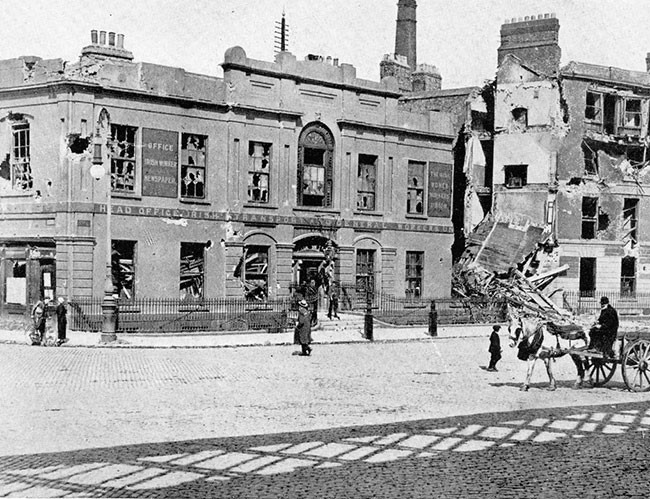
• Liberty Hall levelled by British artillery
On the Sunday before Easter Sunday the green flag of Ireland was raised over Liberty Hall as the Citizen Army paraded.
On Easter Sunday at 9am the Military Council held its crisis meeting in Liberty Hall after Mac Neill’s countermanding order. They decided to postpone the Rising until Easter Monday and ordered the printing of the Proclamation on the Liberty Hall printing press.
From Liberty Hall on Easter Monday the GPO and St. Stephen’s Green garrisons marched out and 15 cars and lorries carried munitions from the Hall to the GPO that afternoon.
On Wednesday the British gunboat Helga began bombarding Liberty Hall which was reduced to ruins.
The South Dublin Union
The Irish Volunteers of the Fourth Battallion, Dublin Brigade, under Commandant Éamonn Ceannt, assembled at Emerald Square, Dolphin’s Barn, on Easter Monday. Ceannt was more suited to a military role than perhaps any of the other six members of the Provisional Government of the Republic and the Rising. Around 130 men mobilised and Ceannt’s second in command was Cathal Brugha.

• South Dublin Union
The South Dublin Union, where the St James’s Hospital complex now stands, covered a very large site with many buildings and wide open spaces and was hugely difficult to defend with such a small number of Volunteers. Outposts included Roe’s Distillery, Mount Brown and Marrowbone Lane. The British Army soon entered the Union grounds and a fierce battle ensued. There were gun battles and hand-to-hand fighting between and inside buildings. The South Dublin Union garrison held out until their surrender on Sunday. Seven Volunteers were killed and Eamonn Ceannt and Con Colbert were executed. During the battle the wounded Cathal Brugha had propped himself up and prepared to resist an assault by British troops. He received over 20 wounds but survived the Rising to become a member of the First Dáil Éireann and Minister of Defence of the Irish Republic. He died defending the Republic in the O’Connell Street battle in the first week of the Civil War.
St. Stephen’s Green
It is believed that in the original plans for the Rising St. Stephen’s Green was to be a centre for transport and supplies and the buildings around it, including the Shelbourne Hotel and nearby Harcourt Street Railway Station, were to be occupied.
On Easter Monday Michael Mallin, Chief of Staff of the Irish Citizen Army, marched from Liberty Hall with around 40 Citizen Army men and women. He never had much more than 100 under his command during Easter Week. At St. Stephen’s Green, Mallin ordered his troops to dig defensive trenches. A detachment barricaded the railway line at Harcourt Street and then returned to the main force at the Green.
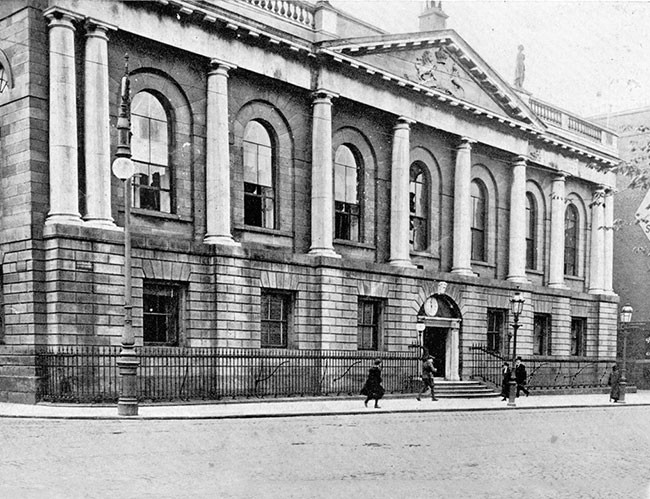
• The College of Surgeons
Constance Markievicz had been assigned to travel between the various garrisons, driving Dr. Kathleen Lynn’s car, but after assisting at City Hall she was asked by Mallin to remain at the Green and he appointed her his second in command.
On Monday night British troops from Dublin Castle made their way under cover to the Shelbourne Hotel and at 4am they opened up with machine-guns on the Republican forces. Mallin ordered retreat to the College of Surgeons. For the rest of the week there was intense firing between the College and the Shelbourne and other British positions. Various attempts to attack or outflank those positions failed. Mallin surrendered on Sunday morning and told the British Army Major de Courcy Wheeler that he had 110 men and 10 women under his command.
North King Street massacre
North King Street in the sector covered by Edward Daly’s 1st Battalion was the scene of a massacre of 15 civilians by the British Army at the end of Easter Week. Some of the fiercest fighting had occurred in this street and the South Staffordshire Regiment of the British Army suffered heavy casualties.
By Saturday morning they had taken control of most of the street. In doing so they had fired indiscriminately into all the houses. But later they went further. It soon emerged that between 6pm on Friday and 10am on Saturday the British Army killed 14 civilians in North King Street and one in Little Britain Street. The men were shot or bayoneted in their homes.
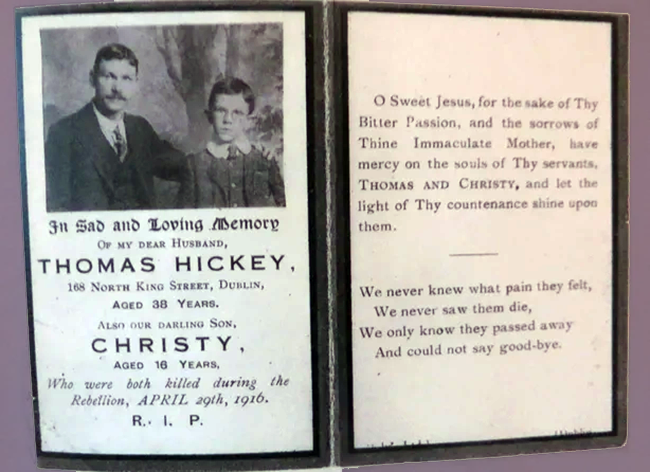
The officers took their cue from the British commander in Dublin, General Lowe who ordered that, “no hesitation was to be shown in dealing with these rebels; that by their actions they had placed themselves outside the law and that they were not be made prisoners”.
But the murdered men were not ‘rebel’ prisoners or potential prisoners but civilians. They were not shot in the heat of the fighting but in cold blood after the British Army had taken the street. Some of the bodies were buried in cellars and gardens.
Jacob’s Factory
Commandant Thomas MacDonagh led the Second Battalion of the Irish Volunteers’ Dublin Brigade. They mobilised at St. Stephen’s Green on Easter Monday and marched to Jacob’s Factory, a very large building commanding much of the South Inner City. Peadar Kearney was a member of the Jacob’s garrison and wrote:
“The position of Jacob’s Factory was such that to attempt to storm it from any point except Bride Street was impossible. The enemy made several attempts to place machine-guns in Digges Street, but each time they did so they were literally blown out of it – and a dozen Howth Mausers could always be relied upon to do just that. They then tried improvised armoured cars – engine boilers from Inchicore Works, loopholed and mounted on lorries, in which they would race up and down Aungier Street, firing volleys up Bishop Street.”
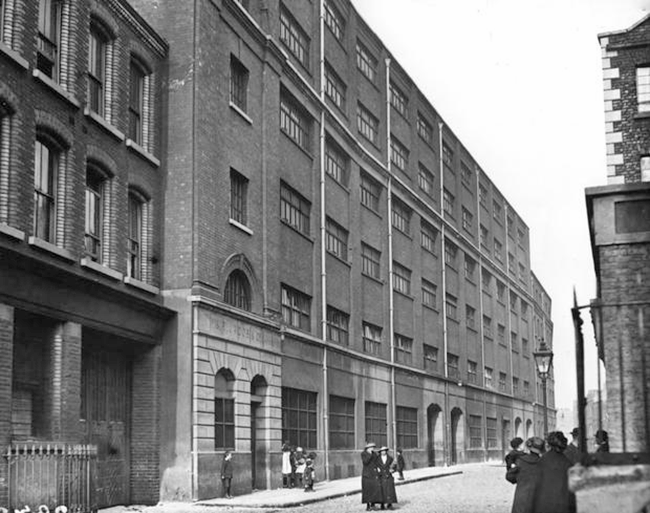
When Pearse’s surrender order reached Thomas MacDonagh he insisted on meeting the British commander General Lowe to confirm the position. He then ordered the surrender which took place at 3pm on Sunday in St Patrick’s Park. Some of the garrison, including Peadar Kearney, managed to escape.
The Battle of Mount Street Bridge
The plan for the Rising tasked the Third Battallion, Dublin Brigade, Irish Volunteers, under Commandant Éamon de Valera, with occupying the south-eastern approaches to the city.
120 of an estimated 400 in the Battalion assembled at Earlsfort Terrace on Easter Monday. Lieutenant Michael Malone and 14 men marched to Mount Street Bridge. They occupied 25 Northumberland Road, the nearby Parochial Hall and school and Clanwilliam House which commanded the bridge itself.
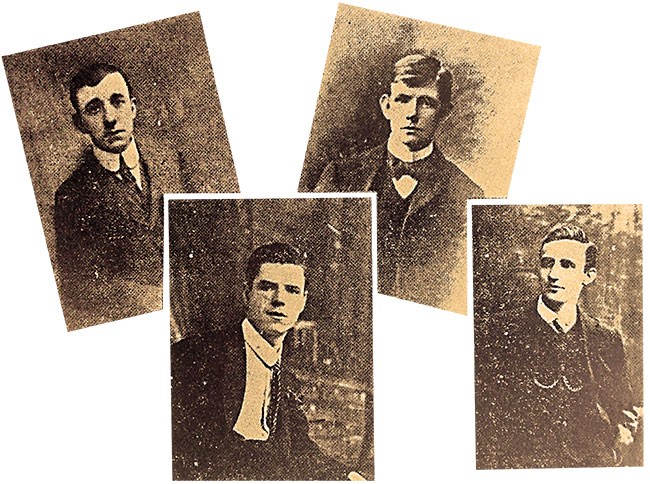
• The Four Volunteers that lost their lives in the battle George Reynolds, Patrick Doyle, Michael Malone and Dick Murphy
British troops of the Sherwood Foresters regiment landed at Dún Laoghaire and just after noon on Wednesday entered Northumberland Road. Malone and Volunteer Jim Grace held them at bay for hours but were unable to prevent the final assault. Malone was driven to the top of the house where he was shot dead. Grace managed to escape.
Clanwilliam House was occupied by seven Volunteers. They poured rifle fire on advancing British troops, causing numerous casualties. But fire from the overwhelming number of British troops was devastating and Clanwilliam House was set ablaze. The bodies of three fallen Volunteers were consumed in the flames.
Four Volunteers were killed in the Battle of Mount Street Bridge. On the British side there were 17 killed and over 200 wounded, many seriously, their highest losses in the Rising.
City Hall
It was apparently not in the plan of the Rising to fully take over Dublin Castle. It was believed that the British garrison in the Castle could be isolated. The task was given to Irish Citizen Army Captain Seán Connolly, a Dublin Corporation clerk well known in Republican circles as an actor and fine singer, whose brothers and sister also took part in the Rising.
He marched off from Liberty Hall on Easter Monday with 30 men and 12 women after James Connolly said to him: “Good luck Seán, we won’t meet again!”
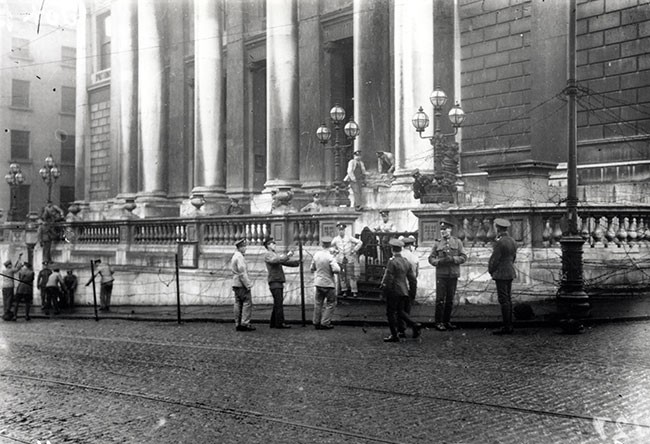
• British Army erect barricades at City Hall
Sections went to occupy various posts near the Castle, including City Hall, and Seán Connolly led a section to the Castle gates. In a confrontation at the gate he shot dead a Dublin Metropolitan Policeman and ordered the taking of the nearby guard-room.
The British soldiers inside were captured and tied up and the guard-room was held by Connolly’s men for most of Monday. Meanwhile a fire-fight began between the Republicans in City Hall and the soldiers in the Castle. On the roof of City Hall Seán Connolly was shot and was attended by Dr. Kathleen Lynn and Helena Molony but he quickly died of his wounds.
Late on Monday British troops gained access to City Hall and Kathleen Lynn, the last in command, surrendered on Tuesday morning. The Republicans occupying adjacent buildings continued the fight but had to retreat and most escaped across roof-tops.
Mendicity Institution
Captain Seán Heuston was detailed to hold the Mendicity Institution on Usher’s Island on the south quays on Easter Monday for a few hours to impede British military movement while Edward Daly established his position on the north side of the Liffey.
At 11am on Easter Monday James Connolly ordered Heuston to take the building. He had less than 15 men to do so but quickly occupied and fortified it and shortly afterwards opened fire on British troops on the quays. The British then turned their fire on the building and Heuston received reinforcements from the GPO of over a dozen men from the Swords company of the Volunteers.
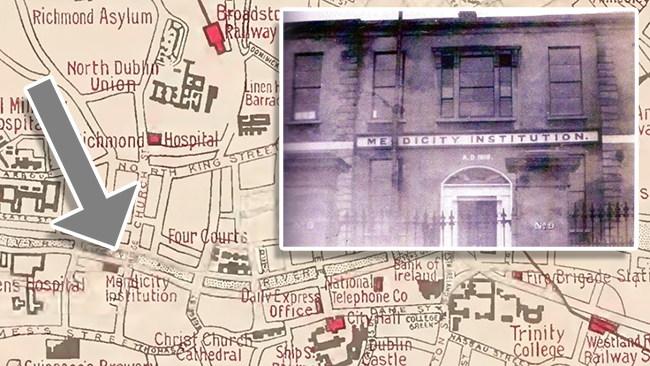
On Tuesday the building was surrounded by British troops and under intense fire. On Wednesday morning the British threw grenades through the windows and Volunteers caught several of them and threw them back.
By Wednesday afternoon it was clear to Heuston that they could not hold out any longer and he ordered surrender. As the men marched out under a white flag Volunteer Peter Wilson of Swords was shot dead by a British sniper.
Follow us on Facebook
An Phoblacht on Twitter
Uncomfortable Conversations

An initiative for dialogue
for reconciliation
— — — — — — —
Contributions from key figures in the churches, academia and wider civic society as well as senior republican figures




